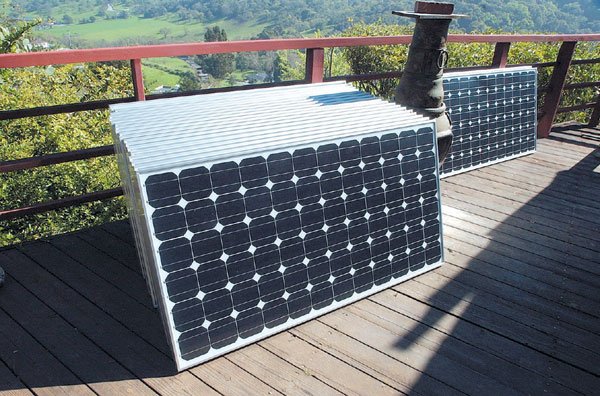Peter Walsh and his wife Lyn Manning loved their new home, a
spacious four-acre property in the hills above Watsonville
Road.
Their purchase came with everything they’d been looking for,
including a pool and gorgeous views, but when their last electric
bill came, the couple took a collective gasp
Peter Walsh and his wife Lyn Manning loved their new home, a spacious four-acre property in the hills above Watsonville Road.
Their purchase came with everything they’d been looking for, including a pool and gorgeous views, but when their last electric bill came, the couple took a collective gasp. They owed $375 dollars for just one month of service.
“When we bought this house, which we did last May, we knew it was all electric,” said Walsh, a semi-retired documentary filmmaker who now devotes his time to taking photographs and writing articles. “We’d lived in a home with a propane heater and stove before, and we had no idea (about the price that would accompany electric services).”
The home included a solar-powered water heater installed by Solahart of San Martin that worked so well it gave the couple an idea. If the sun could warm enough water to allow them enough hot water for four showers, one dishwasher run and a load of laundry, surely there must be a photovoltaic system capable of powering their entire home.
“When I was in Japan in ’82, almost half the houses had solar water heaters, so I knew the United States was way behind on this,” said Walsh. “I just thought that now, with this big contest for resources like oil between consuming countries, it’s just going to get more expensive, and we need to have alternatives.”
For more information on solar-powered electric systems, Walsh and Manning turned to a Sierra Club meeting on the very subject and discovered that not only was it possible, the state of California would pay 30 percent of their installation cost as a rebate.
The couple took out a loan against their newly purchased home and then waited two months for the 32 solar panels that now coat their broad southern roofline, capable of generating 4.9 kilowatts of power, installed about a month ago.
At a price tag of nearly $25,000 before a rebate, it wasn’t a cheap move, but the process will pay off in the long run.
While the power system Walsh and Manning installed cannot save power for use at a later date, it can feed excess power back into the PG&E grid. The power company credits the couple 30 cents per kilowatt hour, or $3 per watt. During the night, when the system isn’t producing power, the couple buys electricity back from PG&E for 8 cents per kilowatt hour, or 80 cents per watt.
“In the first five to seven years, we’ll never have a big bill, but we’ll be paying off the cost of the installation,” said Walsh. “By the time winter comes, we’ll have so many credits to spend, but the best part is that in five to seven years, we’ll never have to pay for electricity again. It’s only going to get more expensive, and this will cut the cost and improve the value of the property.”
Most photovoltaic panels are guaranteed to last between 20 and 25 years, according to the U.S. Department of Energy, though many can last more than 30 with proper care and maintenance.
The rebates that Walsh gets are provided by PG&E, though he’ll never get a check in the mail.
Instead, the power provider runs a program called E-net, where users have digital meters installed that can count power drawn and power generated by the individual.
Consumers earn credits for each watt of electricity they sell, and the credits volley back and forth throughout the year as power usage rises and falls. At the end of the 12 month period, the homeowner either pays the debt or receives a clean slate with which to begin the next year’s credit balance.
“There are a lot of other financial benefits that a solar user enjoys besides a reduced electric bill,” said PG&E spokesman Paul Moreno. “PG&E incurs costs to hook up customers, and bear in mind, the sun goes down at night.
They draw from us then, so while a lot of that goes back into the system during the day, we still have to provide the infrastructure and such to the customer to utilize the grid even though they’re not buying as much electricity from the company.”
Businesses that generate more than 30 kilowatts of their electric use from photovoltaic or other alternative sources are eligible for PG&E rebates thanks to the passage of Assembly Bill 970 in September 2000.
The bill called for the creation of more supply-and-demand energy programs throughout the state, and by March 2001, the California Public Utilities Commission had responded by creating a program offering financial incentives to customers who self-generated all or a portion of their energy needs.
The program has been too successful for providers like PG&E to match the demand, with the current waiting list capped at 366 applicants requesting $314 million in aid for large-scale projects, according to the PG&E Web site. Such projects generally are approved to put in place solar power that will feed schools, libraries and municipal systems, according to Moreno.
Representatives from the company, along with other power suppliers, including those from Southern California Gas Company, met at a public workshop on Feb. 17 to discuss the development of a declining rebate schedule and develop an exit strategy from the program, which they intend to submit to the California Public Utilities Commission for consideration. Currently, the program has been approved to continue until 2007 based on votes within the state assembly.
Some cities with their own water and power companies do pay customers for excess electricity generated.
Silicon Valley Power, which serves the city of Santa Clara, will pay residential customers $4 per watt with a cap of $16,000, while Palo Alto PV Partners offers the same $4 with no restrictions, according to the Web site www.CaliforniaSolarCenter.org, a clearinghouse for solar power and rebate information. The Green LA Solar Program is most generous, according to the site, paying consumers $6 per watt for power generated within Los Angeles’ city limits.
For residents interested in installing their own solar systems, the California Energy Commission offers a system calculator that can help those interested find out how much the system would cost to install, how much the average rebate would be and what the overall financial and environmental savings of the project would add up to in the end.
The calculation for this rebate amount is a complex one, involving not only specifics about the photovoltaic system homeowners intend to install, such as size, direction, tilt and maintenance of system components, but personal information such as tax filing status, income, yearly electric bills and payment methods as well as projected annual escalation of electricity consumption.
For more information on the California Electricity Commission estimator, or to try it out for yourself, visit www.consumerenergycenter.org/renewable/estimator/index.html.
And for homeowners and apartment managers interested in learning more about photovoltaic systems, the Sierra Club will be holding a solar seminar at the Morgan Hill Library on April 23 from 1:30pm to 4:30pm. For more information, contact Kurt Newick of Horizon Energy at (408) 370-9636.













